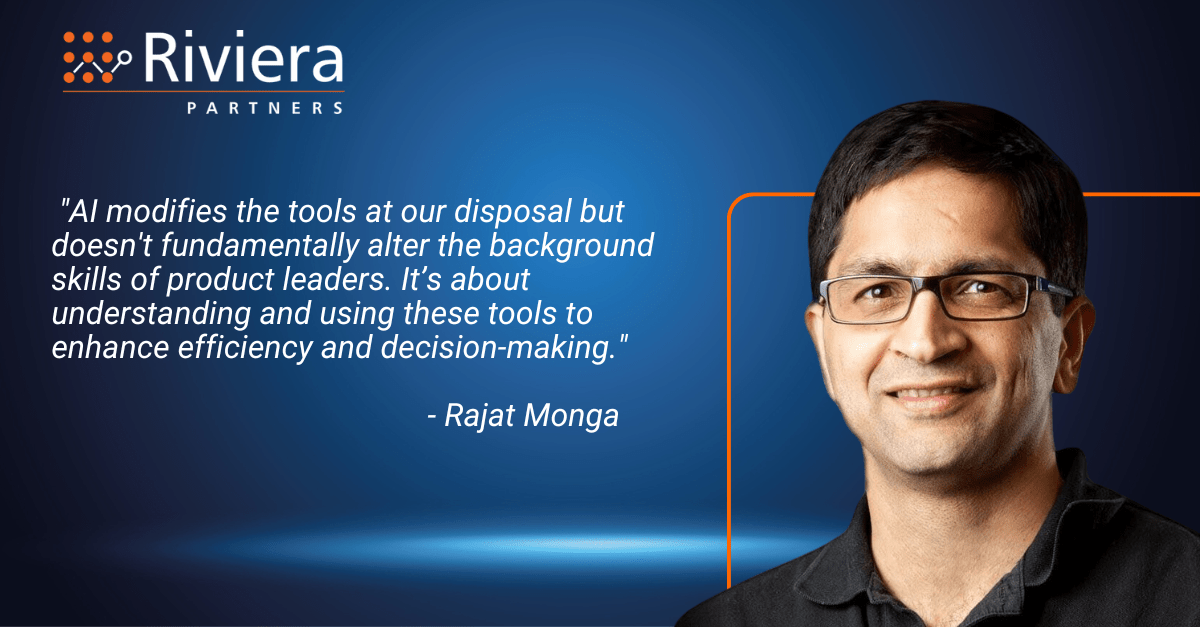
As AI continues to revolutionize industries, its impact on product leadership is becoming increasingly significant. Partner, Sam Wilkins sat down for a recent interview with Rajat Monga, co-founder of TensorFlow and a leading voice in AI development, to explore how product leaders can adapt to the evolving landscape. Rajat shares his insights on integrating AI into product management, the evolving roles within tech teams, and the importance of maintaining core leadership skills amidst technological advancements.
Sam: Rajat, there’s a lot of curiosity in the market about how AI might impact the remits of product leaders. Given your experience within Google Brain, then founding TensorFlow, and then building your own company, you have seen multiple contexts. What is your perspective on areas where Product leaders might need to adapt when specifically building AI powered systems?
Rajat: AI is reshaping roles, but the fundamentals of understanding customer needs in a product remit remain unchanged. What’s crucial is integrating AI as a tool, enhancing rather than replacing the skills we rely on.
Sam: So, you’re not seeing a shift in the requirements / foundational knowledge of product leaders to be able to operate effectively when deploying AI into products?
Rajat: Exactly. AI modifies the tools at our disposal but doesn’t fundamentally alter the background skills of product leaders. It’s about understanding and using these tools to enhance efficiency and decision-making. For instance, AI can streamline coding but doesn’t eliminate the need for engineers who understand broader systems and architectures, there will still be a human intervention loop.
Sam: With the advancement of coding co-pilots, we’re seeking a shift to where some companies are planning on a diamond shaped org structures where the bulk of people are experienced and then the org tapers off when the team becomes more junior. Do you see this as a trend considering co-pilots still work best with human and in the loop and how does this affect people getting onto the work ladder as engineers.
Rajat: That seems like a short-sighted move by companies. Those thinking long term all appreciate they need to be continually training the leaders of tomorrow from younger recruits.
Sam: How about the team dynamics? Are roles or the ratio of engineers, data scientists, and product managers changing with AI?
Rajat: The roles are evolving, but not displacing. Data scientists, for instance, will also see their tasks simplified as models become ‘low code’ to deploy as software engineering has but you’ll still need them involved for tuning and defining the parameters.
A more significant shift will be the ability for Product managers to hold in their minds that the outputs of software powered by neural nets are not exact in the way they are with traditional software. AI may sometimes provide inaccurate results in the product. How different products leverage AI – this amazing but sometimes inaccurate technology – is a work in progress.
Sam: Looking at organizational structures, we see an ebb and flow of desired models for Product and Engineering being peer functions versus both being run by one person. Will the rise of AI have any impact on this organizational decision making?
Rajat: The convergence of product and engineering roles won’t driven by the rise of AI but by the eternal need for integrated leadership in whichever form makes sense for the founding team.
Sam: Finally, any thoughts on the current remote/hybrid/in-office tradeoffs? Has AI changed the way we should approach team dynamics or compensation? After a couple of years out of COVID, we’ve still not seen any concrete data on the impacts, positive or negative on remote v hybrid v in-person.
Rajat: There had obviously always been a small number of remote first companies pre-COVID. That number has increased significantly but there appears to be a snap back to in-person for at least 3-4days/week. Remote work has recalibrated expectations. It’s about finding a balance—maintaining productivity while fostering a culture that supports both remote and in-office dynamics. There’s always the cases of benefits in being able to employ the expert who has chosen to live outside of core tech hubs versus only picking from those who can commute in.
Sam: Rajat, thanks for shedding light on these aspects. It’s clear that while AI transforms tools and workflows, the core principles of product and engineering leadership persist, adapting to new capabilities.
Rajat: Absolutely, Sam. It’s about leveraging AI responsibly and strategically to enhance, not replace, the human elements of our roles.
